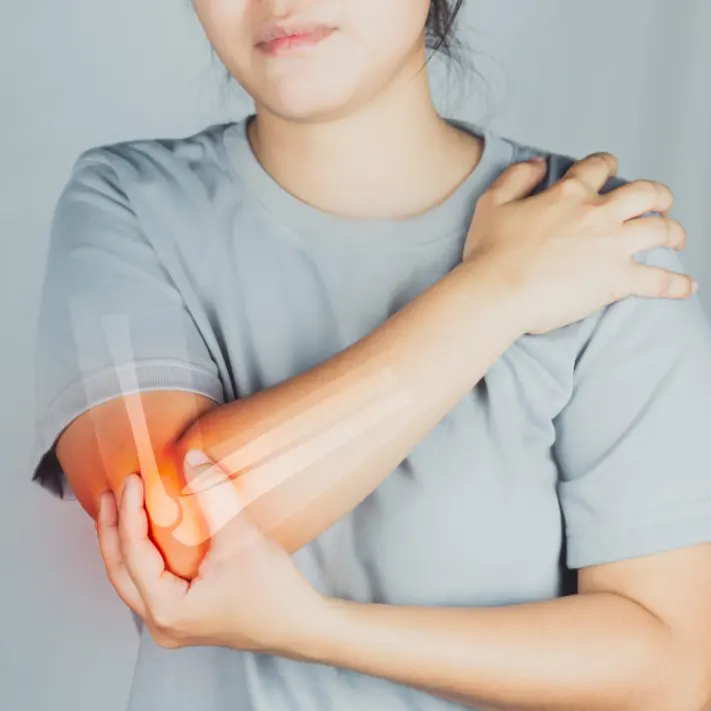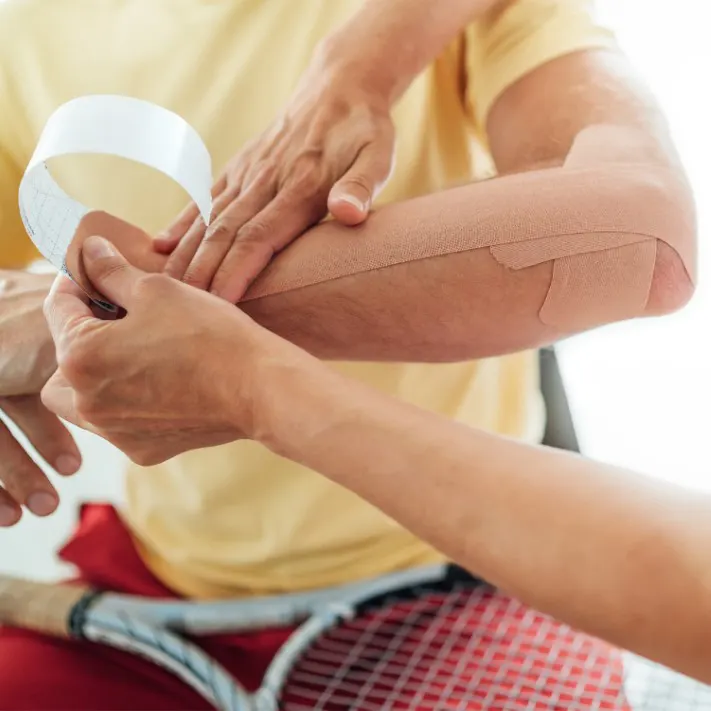What is Tennis Elbow?
Tennis elbow, also known as lateral epicondylitis, is an injury caused by the overuse of the tendons that join the muscles of the top of the forearm to the outside of your elbow. The elbow may become very painful when excess strain is placed on these muscles, often associated with the repetitive gripping and lifting of a tennis racquet. Tennis elbow is caused by tendon inflammation, tearing, or degeneration which can lead to a decrease in range of motion, strength and function of the elbow, forearm, wrist, and hand.
Understanding Elbow Anatomy
The elbow is a hinge joint that contains three bones. Two bones are located in the forearm (the ulna and radius), and one is the upper arm (the humerus). The ends of all three bones are surrounded by cushioning cartilage and synovial fluid, allowing the bones smooth movement and protection from absorbing shock. In addition to bones, the elbow contains two major tendons, three main nerves, four ligaments, and seven muscles. The elbow is a fulcrum that helps the arm and hand perform everyday tasks. It is powered by the bicep muscle and allows the arm/hand to lift, hold, and move objects. The elbow also enables the arm to bend and straighten. The elbow may become stressed from performing repetitive movements and/or bearing the brunt of strenuous force, making it particularly susceptible to injury, overuse, and wear and tear.
Causes of Tennis Elbow
Tennis elbow is most often caused by playing racquet sports like tennis or pickleball. Symptoms may come on suddenly or develop more slowly over a long period of time. Although it has the name tennis elbow, this condition may also be the result of:
- Jobs in construction, manufacturing, cashiering, cooking, or computer work
- Sewing, knitting, crafting, gardening
- An acute injury from hitting the outside of the elbow

Tennis Elbow Treatment
Tennis elbow treatment at Armworks Hand Therapy is not achieved with a one-size-fits-all approach. Your first appointment with Armworks with consist of thorough, professional evaluation of your hand therapist. They will assess your injury, listen to your concerns, and answer your questions. Your hand therapist will then create a customized rehab plan built for your specific recovery needs. Your tennis elbow treatment regimen may include:
- Treatment/instructions to reduce inflammation
- Manual Therapy
- Splinting for elbow and/or wrist
- In clinic and at home exercise programs
- Education on correct use of your arm

Frequently Asked Questions
-
How will my tennis elbow symptoms progress?
A typical progression of symptoms starts with an occasional dull ache or brief sharp pains on the outside of the elbow which can then go into more frequent or longer periods of pain. This pain will eventually lead you to avoid using your arm which will cause weakness and loss of motion.
-
When should I seek tennis elbow treatment?
In short, the earlier you can start therapy the better. The most common thing hand therapists hear from patients is, “I just thought it would go away so I waited to call” but by waiting the recovery period lasts much longer.
-
How long will tennis elbow treatment typically last?
If treatment starts quickly after your symptoms begin, tennis elbow treatment can take 4-6 weeks. If treatment is delayed, then it can take up to 12 weeks or more.
-
When can I return to work after starting tennis elbow treatment?
The muscles involved with tennis elbow are most stressed during tasks that require reaching, turning, lifting, or grasping. The more often you need to perform these types of movements or tasks then the longer it will take to return to work. Most of the time people are back to their normal work within 6-8 weeks.
-
When can I return to playing tennis if I have tennis elbow?
Racquet sports require a lot of reaching, twisting and wrist motion. There is a big variation in the timeline for when you should return to the tennis court. However, the key thing to think about is returning with progression. This means you would start with an easy activity (i.e., hitting a tennis ball for just a few minutes against a wall) and then move up the difficulty in small steps. Next you could begin light hitting back and forth with a partner and gradually increase the time and/or number of hits based on your pain. The final step in the process would be getting back to playing tennis matches.
-
Does Armworks take my insurance?
Here is a list of the insurance plans accepted by SportsCare Physical Therapy and Armworks Hand Therapy. If you are unsure of your coverage or if your plan is accepted, please contact one of our offices. We are happy to assist you in learning about your benefits.
-
Where is Armworks located?
Armworks Hand Therapy has offices in Gresham, NE Portland, Clackamas, Beaverton, Tigard and Salem. For location specific contact information click here.
